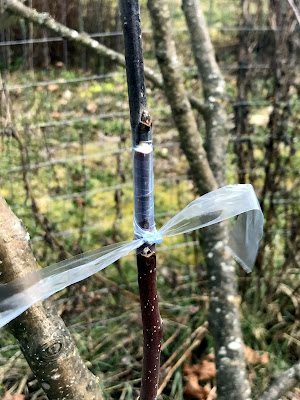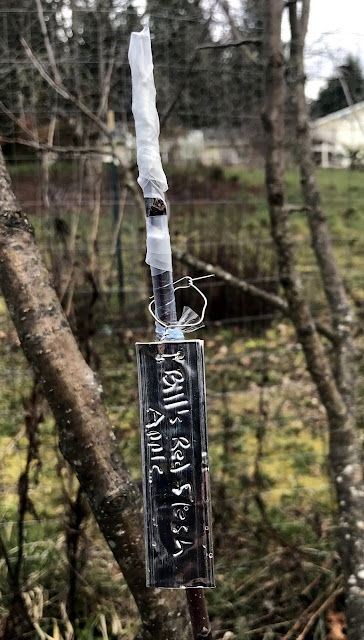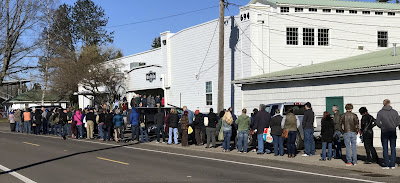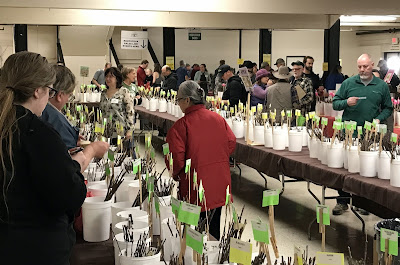 |
| Northpole, 19 years old. 3.25.19 |
I've been growing a
Northpole™ columnar apple for about 18 years. In 2012 I added columnar Scarlet Sentinel™ and Golden™ Sentinel. This year, I also added columnar Urban Apples
®, "Tasty Red
®" and "Golden Treat
®". Next door to my old place in Vancouver is a gigantic old apple tree that gets no maintenance and has a high insect and disease load, so the Northpole™ suffers from that contagion. Even so, they are a nice McIntosh-like apple. Last year I had a few dozen nice, crisp, juicy, good looking, tasty apples from that tree, suitable for fresh eating, apple sauce, and pies. The tree does require some pruning to keep it the right shape and size. That pruning is not a challenge unless I let it go a few years.
Nurseries have been promoting columnar apple trees for a generation now. Columnar apple trees are not a pruning technique, but rather the way that those trees tend to grow naturally. The
gene for the columnar shape (
Co/co) is known, and causes thick stems, short internodes, and reduced side branches. The columnar form is dominant, meaning that if the columnar and normal genes are both present, the tree will still be columnar. However, there are other controlling factors, and
in one study of tree and spur shapes, involving 28,000 apple seedlings, 44% of seedlings that were grown from columnar x columnar trees had a columnar shape.
Columnar apple trees look cool in the photos, and the concept is interesting. A columnar tree takes up much less garden floor space compared to a mid range semi-dwarf tree, but about like a micro-mini apple on M27. However, unlike the mini apples, the columnar trees can grow taller, for a bigger crop.
Some articles propose that columnar trees could be advantageous in commercial orchards, due to the ability to plant them close together and not have to prune as much. Height and shape depend on vigor, rootstock, and pruning. Several can be planted as columnar accent trees in a yard, or in a row as a hedge, looking very nice when in bloom and fruit, and even when leafless.
Almost all columnar apple trees are descended from a single sport mutation found in 1961, on one McIntosh apple tree in Vancouver, Canada. That sport mutation was commercialized and sold as "McIntosh Wijcik." If crossed with any
other apple variety, you should get roughly one half columnar and roughly
one half normal progeny. The actual percentage will depend on whether the columnar parent has one or two copies of the columnar gene. The columnar mutation has been traced to a
single gene. First generation hybrids have 50% McIntosh in their makeup.
In subsequent generations the McIntosh DNA dilutes out, but if you keep only the columnar progeny, they will all have columnar shape regardless of what the apple looks like.
 |
| Northpole, 19 years old. 3.25.19 |
Since columnar apple trees are all descended from a single sport on a single tree, they all have at least a little McIntosh in their ancestry. However, if they are out-crossed for a few generations, the 2nd generation is 50% McIntosh, the 3rd generation is 25% McIntosh, and the 4th generation is 12.5% McIntosh. And so on. Little information is readily available regarding how many generations most columnar trees are, from their original Macintosh progenitor. In theory, you could make a very flavorful, disease resistant columnar apple tree cultivar if you are so motivated, young, live long enough, and use promising parents. For example, using one of the PRI disease resistant varieties as a parent, or possibly one of the disease resistant redflesh apples, could result in unique and good tasting, disease resistant columnar apple trees.
Some other names for Columnar apple trees include Colonnade®, Ballerina®, and Urban Apple® trees.
For example, the Ballerina® series, from Orange Pippin and originating in the UK, descend from Wijick. They appear to be trademarked, I'm not sure
about patent. Examples are
Flamenco® and "
Samba® "protected varieties. Samba
® is described as a cross of Flamenco
® x Fallstaff
® and has side shoots which can become vertical". From the internet catalog description, I'm not convinced that Samba
® is truly a columnar variety.
Each columnar apple tree series has its own selections, such as a red variety, a green one, and a yellow one. For example, the "
Urban Apples®" developed in Czechoslovakia by Dr Jaroslav Tupy, include those three colors and a "blush" color. I'm not sure about the protected status of these trees, for home grafters. I spent a lot of time looking for patent information for that series, but found patent only on "
Blushing Delight®" under the name "
Moonlight®" (cross between Goldstar and Telamon).
Patent info. I found trademark notations for the others (
Tasty Red®,
Golden Treat®, and
Tasty Green®) which does not restrict propagation but prevents you from calling the propagated trees by the trademarked names. I don't know the best solution for that issue - maybe (and I'm not a patent or trademark lawyer) call one something like "Red Lancelot" and note "compare to Scarlett Sentinel
™ as an example?
One columnar apple progeny was
Golden Sentinel™. That was being trialed in 1996 in
Canada - where Wijcik originated- but I think NorthPole™ is older. I am
pretty sure my North Pole tree is at least 19 years old, and I doubt it
was one of the earliest ones.
Scarlett Sentinel™ looks to be progeny of the same parents as Golden Sentinel, just a different sibling.
According to the Canadian Food Inspection Agency, "
'Golden Sentinel' originated from a cross made in 1986
at the Agriculture & Agri-Food Canada, in Summerland, British
Columbia. The cross was 'Discovery' x 8C-17-36. 8C-17-36 originated from
a Wijcik Spur MacIntosh x Delicious cross."
Regarding Scarlett Sentinel™,
the same Canadian reference states "
'Scarlett Sentinel' originated from a cross made in
1986 at the Agriculture & Agri-Food Canada, in Summerland, British
Columbia. The cross was 'Discovery' x 8C-17-36. 8C-17-36 originated from
a Wijcik Spur MacIntosh x Delicious cross.
Both Scarlett Sentinel™
and Golden Sentinel™ are protected in Canada until 2020-03-04, but I could not find that these trees are patented in the USA. Due to uncertainty, I have not shared scion for these two cultivars.
Orange Pippin describes "Discovery", one of the parents of the Sentinel trees, as one of the most important English apples, a hybrid between Worcester Permain and an unknown parent, possibly "
Beauty of Bath". That makes both Scarlet Sentinel and Golden Sentinel hybrids with solid apple parentage - (Macintosh (Wijcyk) x Delicious) x (Worcester Pearmain x unknown).
Examples of crosses with Wijcik or its progeny - again, actually McIntosh, include:
Obelisk® - "Developed in UK at East Malling, (Cox's Orange Pippin x Court Pendu Plat) x Wijcik
(U.S. Plant Pat. No. 4,382).
Patent for Obelisk expired 2014-01-10. "
attractive small to medium sized fruit having a yellow ground color with
a high degree of somewhat striped rich maroon red overcolor that
commonly can be cold-stored until approximately April while present in
an ambient atmosphere". In the patent information, Obelisk
® was to be marketed under the "Flamenco
®" name.
Rosalee® "a cross between ‘Aneta’ (female parent, unpatented) and ‘Maypole’ (male parent, U.S. Plant Pat. No. 6,184). and which has V
f-resistance against scab, Telemon "Wijcik variety (U.S. Plant Pat. No. 4,382) of McIntosh apple tree, and the Golden Delicious apple tree.", patent expires 2033-05-16
Dalitron® - Parents listed as ‘Golden Delicious’ and pollen parent ‘Pilot’. Patent expires 2024-11-13
Hercules® The female parent (i.e., the seed parent) was the Wijcik variety (U.S.
Plant Pat. No. 4,382) and the male parent (i.e., pollen parent) was the
Greensleeves variety (non-patented in the United States), Patent expired 2014-01-10.
Also known as "Charlotte".
Maypole® An ornamental crabapple. The parents of the new variety were the Wijcik variety (U.S. Plant Pat. No. 4,382 vs. 6184) of McIntosh apple tree, and Malus Baskatong. The patent for
Maypole expired 2006-04-15.
Goldlane®. An apple tree devoloped in Czech Republic by, and patented by, Jaroslav Tupy et al, who developed the Urban Apple series. Scab resistant. Patent expires 2029-01-07.
Bolero (Tuscan). US Plant Patent 6225
Telamon® (U.S. Plant Pat. No.
6,224)
Telemon is also known as "Waltz
®" US Plant Patent Number 6,224. Patent expired 2006-04-15. A UK, East Malling cross, Golden Delicious x Wijcik. "medium-sized asymmetric generally round-conical fruit havig a
yellow-green skin coloration bearing a substantial quantity of red
flush.
Trajan®. Also a UK, East Malling cross, parentage Golden Delicious x Wijcik. (U.S. Plant Pat. No.
6,226) The patent for Trajan
expired 2006-04-15. "medium-sized asymmetric generally round-conical fruit having a
yellow-green skin coloration with a red flush having prominent lenticels".
Jefgreen® - a colmunar, cold hardy, flowering crabapple
USPP23863P2 expires 2032-02-10
There are also two columnar mutations known from the cultivar "Cripps Pink
®" that are not derived from McIntosh Wijcik but rather are spontaneous mutations directly from Cripps Pink
® and are patented. One is "
Pink Chief®" (US Patent PP27187P3, expires in 2034), while the other is ‘PLFOG99’ (syn. ‘
Pink Belle®’, U.S. Plant Pat. No. 21,555). Since these are two spontaneous mutations of Cripps Pink
®, maybe that variety has some genetic instability, or maybe the columnar mutations will be more commonly found in the future for other cultivars.
(Part of this post is derived from info that I posted previously on
GardenWeb in a different way. I am adding significantly to that info and providing
references here. Patent information and links are provided so that it's as clear as I can make it, as to what varieties are or are not patented. It can be confusing because some cultivars are actually renamed versions of others.) Since I've become more interested in columnar apples, I plan to post photos of the trees as the bloom and produce this year, and better reviews of the trees and apples from my own orchard and yard. For any one interested in the patent and trademark info, please know that I am an amateur, so propagate at your own risk. I don't have nursery sources for the older columnar varieties but would like to find some.)
Edit: I removed Antietam Blush, which is bred from McIntosh Wijcik but in the videos and internet information, I don't see that it is columnar
























Some other names for Columnar apple trees include Colonnade®, Ballerina®, and Urban Apple® trees.
For example, the Ballerina® series, from Orange Pippin and originating in the UK, descend from Wijick. They appear to be trademarked, I'm not sure about patent. Examples are Flamenco® and "Samba® "protected varieties. Samba® is described as a cross of Flamenco® x Fallstaff® and has side shoots which can become vertical". From the internet catalog description, I'm not convinced that Samba® is truly a columnar variety.
Each columnar apple tree series has its own selections, such as a red variety, a green one, and a yellow one. For example, the "Urban Apples®" developed in Czechoslovakia by Dr Jaroslav Tupy, include those three colors and a "blush" color. I'm not sure about the protected status of these trees, for home grafters. I spent a lot of time looking for patent information for that series, but found patent only on "Blushing Delight®" under the name "Moonlight®" (cross between Goldstar and Telamon). Patent info. I found trademark notations for the others (Tasty Red®, Golden Treat®, and Tasty Green®) which does not restrict propagation but prevents you from calling the propagated trees by the trademarked names. I don't know the best solution for that issue - maybe (and I'm not a patent or trademark lawyer) call one something like "Red Lancelot" and note "compare to Scarlett Sentinel™ as an example?
One columnar apple progeny was Golden Sentinel™. That was being trialed in 1996 in Canada - where Wijcik originated- but I think NorthPole™ is older. I am pretty sure my North Pole tree is at least 19 years old, and I doubt it was one of the earliest ones. Scarlett Sentinel™ looks to be progeny of the same parents as Golden Sentinel, just a different sibling. According to the Canadian Food Inspection Agency, "'Golden Sentinel' originated from a cross made in 1986 at the Agriculture & Agri-Food Canada, in Summerland, British Columbia. The cross was 'Discovery' x 8C-17-36. 8C-17-36 originated from a Wijcik Spur MacIntosh x Delicious cross."
Regarding Scarlett Sentinel™, the same Canadian reference states "'Scarlett Sentinel' originated from a cross made in 1986 at the Agriculture & Agri-Food Canada, in Summerland, British Columbia. The cross was 'Discovery' x 8C-17-36. 8C-17-36 originated from a Wijcik Spur MacIntosh x Delicious cross.
Both Scarlett Sentinel™ and Golden Sentinel™ are protected in Canada until 2020-03-04, but I could not find that these trees are patented in the USA. Due to uncertainty, I have not shared scion for these two cultivars.
Orange Pippin describes "Discovery", one of the parents of the Sentinel trees, as one of the most important English apples, a hybrid between Worcester Permain and an unknown parent, possibly "Beauty of Bath". That makes both Scarlet Sentinel and Golden Sentinel hybrids with solid apple parentage - (Macintosh (Wijcyk) x Delicious) x (Worcester Pearmain x unknown).
Examples of crosses with Wijcik or its progeny - again, actually McIntosh, include:
Obelisk® - "Developed in UK at East Malling, (Cox's Orange Pippin x Court Pendu Plat) x Wijcik
(U.S. Plant Pat. No. 4,382). Patent for Obelisk expired 2014-01-10. "attractive small to medium sized fruit having a yellow ground color with a high degree of somewhat striped rich maroon red overcolor that commonly can be cold-stored until approximately April while present in an ambient atmosphere". In the patent information, Obelisk® was to be marketed under the "Flamenco®" name.
Rosalee® "a cross between ‘Aneta’ (female parent, unpatented) and ‘Maypole’ (male parent, U.S. Plant Pat. No. 6,184). and which has Vf-resistance against scab, Telemon "Wijcik variety (U.S. Plant Pat. No. 4,382) of McIntosh apple tree, and the Golden Delicious apple tree.", patent expires 2033-05-16
Dalitron® - Parents listed as ‘Golden Delicious’ and pollen parent ‘Pilot’. Patent expires 2024-11-13
Hercules® The female parent (i.e., the seed parent) was the Wijcik variety (U.S. Plant Pat. No. 4,382) and the male parent (i.e., pollen parent) was the Greensleeves variety (non-patented in the United States), Patent expired 2014-01-10. Also known as "Charlotte".
Maypole® An ornamental crabapple. The parents of the new variety were the Wijcik variety (U.S. Plant Pat. No. 4,382 vs. 6184) of McIntosh apple tree, and Malus Baskatong. The patent for Maypole expired 2006-04-15.
Goldlane®. An apple tree devoloped in Czech Republic by, and patented by, Jaroslav Tupy et al, who developed the Urban Apple series. Scab resistant. Patent expires 2029-01-07.
Bolero (Tuscan). US Plant Patent 6225
Telamon® (U.S. Plant Pat. No. 6,224) Telemon is also known as "Waltz®" US Plant Patent Number 6,224. Patent expired 2006-04-15. A UK, East Malling cross, Golden Delicious x Wijcik. "medium-sized asymmetric generally round-conical fruit havig a yellow-green skin coloration bearing a substantial quantity of red flush.
Trajan®. Also a UK, East Malling cross, parentage Golden Delicious x Wijcik. (U.S. Plant Pat. No. 6,226) The patent for Trajan expired 2006-04-15. "medium-sized asymmetric generally round-conical fruit having a yellow-green skin coloration with a red flush having prominent lenticels".
Jefgreen® - a colmunar, cold hardy, flowering crabapple USPP23863P2 expires 2032-02-10
There are also two columnar mutations known from the cultivar "Cripps Pink®" that are not derived from McIntosh Wijcik but rather are spontaneous mutations directly from Cripps Pink® and are patented. One is "Pink Chief®" (US Patent PP27187P3, expires in 2034), while the other is ‘PLFOG99’ (syn. ‘Pink Belle®’, U.S. Plant Pat. No. 21,555). Since these are two spontaneous mutations of Cripps Pink®, maybe that variety has some genetic instability, or maybe the columnar mutations will be more commonly found in the future for other cultivars.
(Part of this post is derived from info that I posted previously on GardenWeb in a different way. I am adding significantly to that info and providing references here. Patent information and links are provided so that it's as clear as I can make it, as to what varieties are or are not patented. It can be confusing because some cultivars are actually renamed versions of others.) Since I've become more interested in columnar apples, I plan to post photos of the trees as the bloom and produce this year, and better reviews of the trees and apples from my own orchard and yard. For any one interested in the patent and trademark info, please know that I am an amateur, so propagate at your own risk. I don't have nursery sources for the older columnar varieties but would like to find some.)
Edit: I removed Antietam Blush, which is bred from McIntosh Wijcik but in the videos and internet information, I don't see that it is columnar